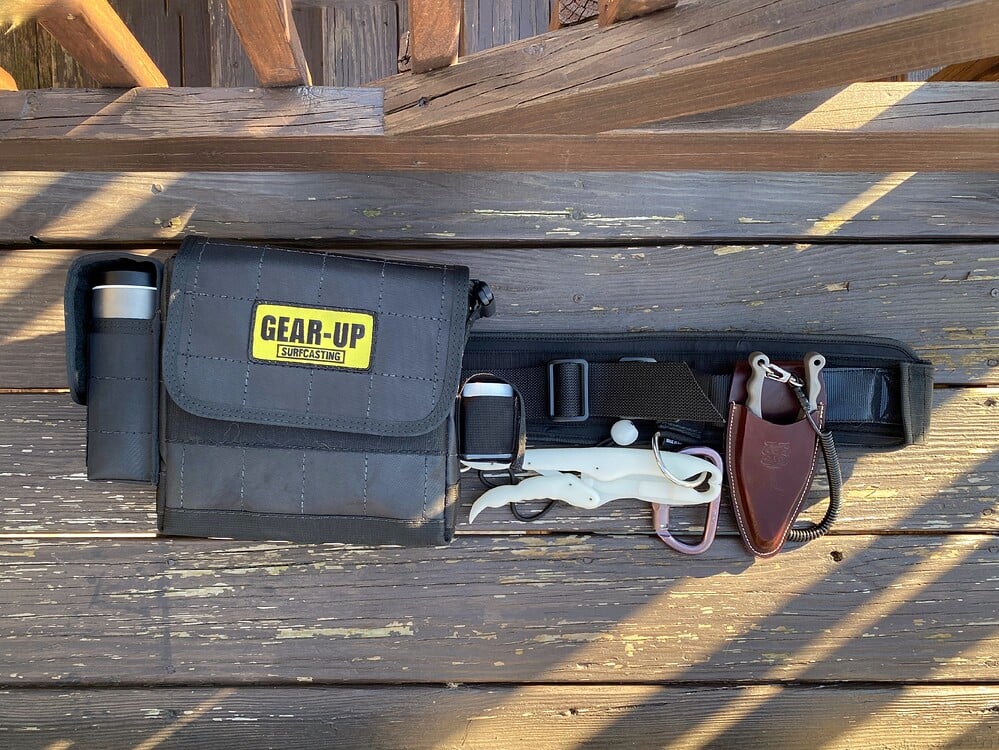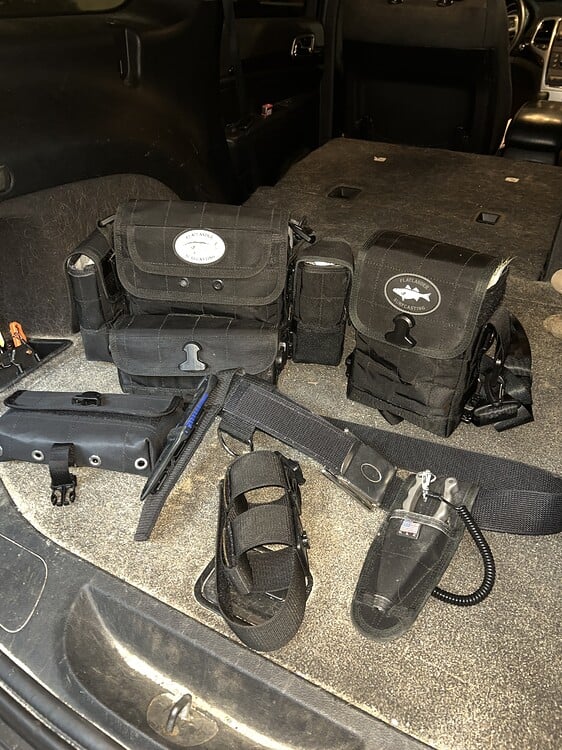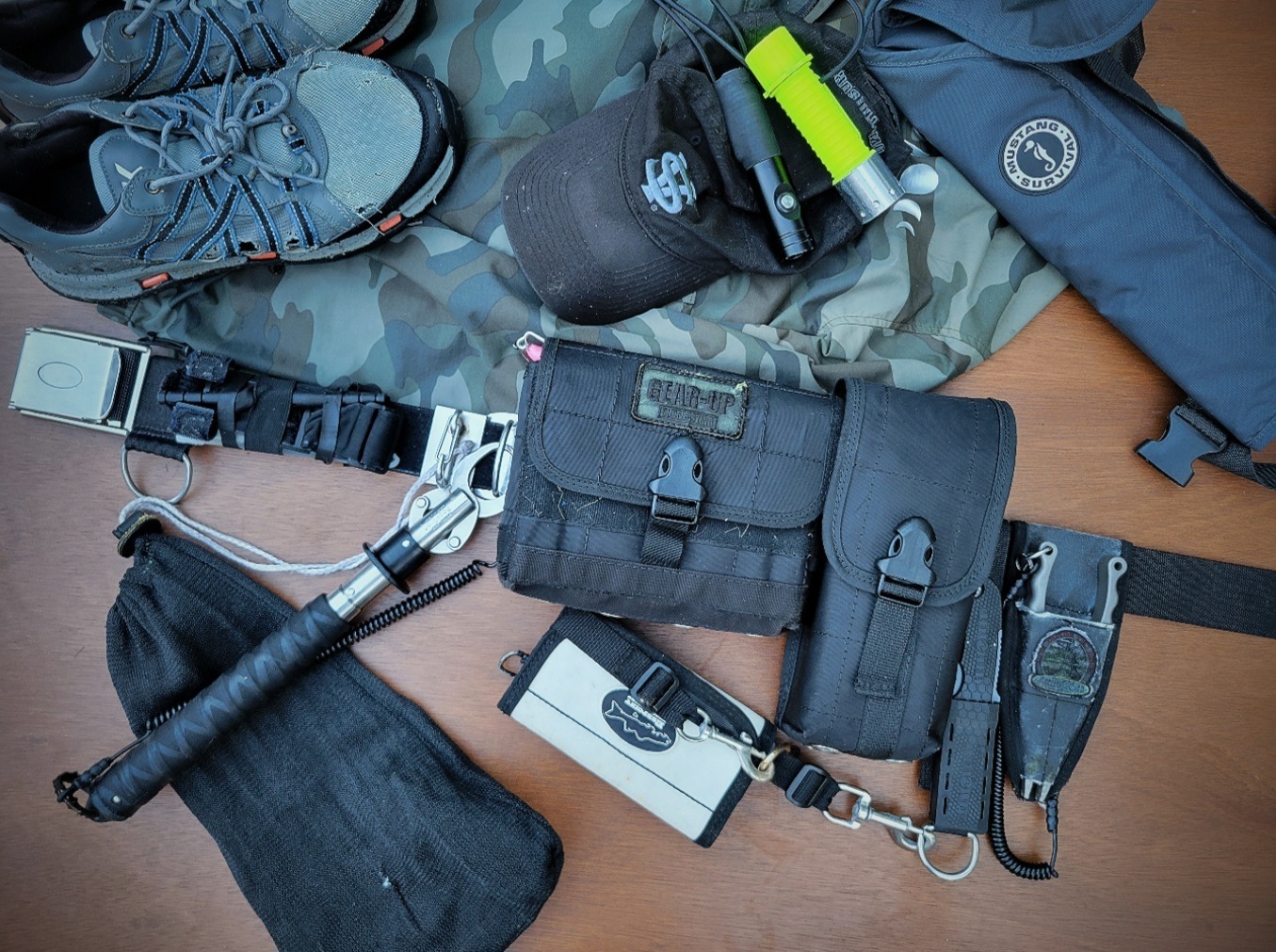Fishing the surf is a difficult game. From fighting the wind and tide, to dodging waves, learning to fish the surf can be a long journey. One key piece to any surf angler's loadout is a good surf belt. A quality surf belt will hold your equipment securely, while keeping water from seeping into your waders.
The evolution of surf belts has come a long way from the simple utility belts of the past. Modern surf belts incorporate sophisticated design elements that address the unique challenges of fishing in turbulent waters. From specialized waterproof compartments to quick-release mechanisms, today's surf belts are engineered to meet the demanding needs of serious surf anglers. Understanding these features and how to optimize them can dramatically improve your fishing experience and success rate.
In today's blog post, we'll highlight 5 surf belts and their accessories, as shared by members of My Fishing Cape Cod in the Surf Belt Setup topic of our private members' only forum. We'll examine each surf belt's configuration, and see different approaches to solving common surf fishing challenges - from surf belts rigged with basic essentials, to more advanced systems designed for extreme conditions.
Through these examples, my hope is that you'll learn not just what equipment to carry, but why each component matters and how to arrange your gear for maximum efficiency. We'll also address crucial safety considerations that every surf angler should understand when assembling their belt system. So whether you're new to surf fishing or looking to upgrade your current surf belt setup, these real-world examples will provide valuable insights into creating the perfect surf belt system for your own needs.
As a side note, I wanted to mention that none of the brands shown below paid to be featured in this post. These are all real-life examples that were generously shared by our members inside the forum. I'm also eager to hear and see more example, so please feel free to leave a comment below, or share a photo of your own surf belt inside our members' forum.
So without further ado, let's dive right in!
1) Essential Surf Belt Setup: A Minimalist's Guide to Efficiency
For surf anglers, the right equipment organization can mean the difference between landing a trophy striper and missing the opportunity of a lifetime. A surf belt serves as the foundation of an efficient surf fishing system, acting as both a practical tool holder and a crucial safety device.
While many newcomers to surf fishing might underestimate the importance of a well-designed surf belt setup, experienced anglers understand that proper gear organization isn't just about convenience – it's about survival and success in challenging conditions.
The first belt featured in today's blog post was shared by Cameron Habib. This belt leans on the simple yet effective side of the spectrum. This belt features a 3 tube Gear-Up Surfcasting bag, a fish grip, Van Staal pliers, and a water bottle holder. The pliers and grips make handling and releasing fish safer and more efficient, while the bag holds more than enough plugs to spend a night in the surf.

The strategic choice of a 3-tube Gear-Up Surfcasting bag is particularly noteworthy, as it provides a nice balance between capacity and mobility. Each tube can accommodate multiple plugs, allowing anglers to carry a sufficient amount of lures without unnecessary bulk. Careful consideration of space management is crucial for surf fishing, where mobility and quick access to gear can make the difference between catching fish and missing opportunities.
The inclusion of Van Staal pliers in this surf belt configuration deserves special attention, as these pliers represent a significant investment in quality that can pay dividends in the harsh surf environment. Unlike standard fishing pliers, Van Staal's corrosion-resistant construction and precise machining ensure reliable performance even after extended exposure to saltwater. When combined with the fish grip, this setup creates a fish handling system that prioritizes both the angler's efficiency and the fish's welfare.
The water bottle holder, while seemingly basic, addresses one of the most overlooked aspects of surf fishing – staying hydrated during long sessions in challenging conditions where returning to your vehicle isn't always practical.
2) Surf Belt with Jig Storage: A Multi-Lure Solution
The next belt is from longtime MFCC member Jeffery Richard. Jeffrey's surf belt configuration demonstrates an important evolution in tackle organization that many anglers discover as they gain experience in the surf. The addition of a dedicated bucktail pouch addresses one of the most common challenges in surf fishing: the need to quickly switch between different lure types as conditions change.
Bucktails and jigs, with their combination of lead heads and flowing materials, require special consideration in storage to prevent tangling. While traditional plug bags excel at protecting larger swimming plugs and surface lures, their tube design isn't optimal for the unique shape and characteristics of bucktail jigs.

By incorporating a dedicated jig pouch into his surf belt system, Jeff's surf belt setup allows for rapid transitions between different fishing techniques – from working a swimming plug in the surface wash to bouncing a bucktail along bottom structure – without losing precious time dealing with tangled jigs.
3) Customizable Surf Belt System: Maximum Versatility for Any Fishing Situation
Surf belts are very customizable as seen in the next belt shared by Tim Mugherini. With 2 interchangeable bags, an extra side pouch, and a bucktail pouch mounted to the front of one of the bags, we can see all the opportunities to customize. Tim's surf belt setup can be rigged small and lightweight for a quick outing, but it can also be "beefed up" for a longer night spent fishing an entire tide.
Tim's surf belt system represents an approach that addresses one of the most challenging aspects of surf fishing: adapting to varying fishing conditions and durations. For example, over the course of a single day on Cape Cod (especially during August and September) a surf angler might start his day targeting albies feeding on rain bait, but then transition to fishing for trophy bass at night.
Each scenario demands different lures and tools, and Tim's customizable system allows for rapid adaptation without the need to completely reorganize gear.

The extra side pouch serves multiple purposes beyond simple storage – it can function as a quick-access point for tools needed in time-critical situations, such as leader material during a blitz or a pair of pliers when a fish is hooked deep.
A common dilemma in surf fishing is that many anglers find themselves either under-equipped for unexpected fishing opportunities or overburdened with unnecessary gear. Tim's approach to surf belt customization solves this problem, making it simple to quickly scale up or down based on real-time conditions and opportunities.
4) Advanced Surf Belt Configuration: Safety and Performance Features
The next surf belt from MFCC member Rich Chouinard is a good example of the safety consciousness that surf anglers develop over years of fishing. The inclusion of a dive knife, in particular, represents a critical safety element that newer anglers often overlook. While many focus on the fishing aspects of their gear, veteran surf anglers understand that the ocean environment demands respect and preparation.
A proper dive knife mounted on a surf belt serves multiple crucial functions beyond emergency situations – from cutting tangled up messes of braided line from rocks to prevent marine life entanglement, to processing bait in a pinch.

The pork rind holder on Rich's surf belt demonstrates his understanding of how subtle modifications to bucktail jigs can dramatically impact fishing success. Pork rind trailers, whether traditional or modern synthetic alternatives, have been a cornerstone of successful surf fishing for generations. The dedicated holder addresses several critical aspects of surf fishing efficiency: it keeps the trailers readily accessible, prevents the material from drying out (in the case of natural pork), and eliminates the need to dig through multiple pouches during critical fishing moments.
The addition of an extra D-ring showcases the kind of forward-thinking approach that separates advanced surf belt setups from basic configurations. The D-ring can serve as an anchor point for various tools – from fish grips to spare pliers – but its true value lies in its versatility.
5) The Ultimate All-Purpose Surf Belt Configuration
The final belt is from MFCC member Calvin Toran-Sandlin. Calvin has shared more information in the MFCC forum than many anglers will learn in a lifetime. His ideas of a surf belt are no different. On this belt, he has 2 small bags, a dive knife, Van Staal Pliers, a Boga grip, eel bag, an extra D-ring/rod holder, and even a tourniquet.

An under-appreciated surf belt tool that we haven't discussed much yet in this post is the lanyard. Waves crash hard and this can make it very easy to lose equipment. Attaching tools to a lanyard will keep them safely on your belt.
The last major part of Calvin's belt is the tourniquet. As Calvin discusses in this extremely thorough surf belt forum post, sharks are a common occurrence where he fishes. However, a more common injury than a shark bite happens from encounters with hooks and sharp rocks. Having a tourniquet on hand for the rare but possible major injury could be a life or death addition for surfcasting in extreme conditions.
Why Every Surf Angler Needs a Well-Equipped Surf Belt: Final Thoughts
Having a well equipped surf belt is key to being successful in the surf. Whether it's for the extreme customization and convenience, or the necessary protection from water filling up your waders. The belts shared by members of our own community strongly demonstrate the versatility and practicality of a good belt to help an angler to stay on the fish rather than fumbling for their tools.
Each component added to a surf belt represents a lesson learned, often through experience that could only come from spending long hours in the surf. The configurations shared in this article demonstrate how different anglers here on MFCC have adapted their setups to address specific challenges, from the minimalist approach of Cameron's belt to the comprehensive safety-first design of Calvin's system.
The true value of a well-designed surf belt extends far beyond mere convenience. In the dynamic environment of surf fishing, where conditions can change rapidly and opportunities appear fleetingly, your belt system becomes an extension of your fishing strategy. The ability to quickly access the right tool or lure without taking your eyes off the water, maintaining your balance on slippery rocks, or losing focus during a blitz can make the difference between success and failure. Moreover, the safety considerations incorporated into these belt systems – from knife placement to emergency medical equipment – reflect the serious nature of surf fishing and the importance of being prepared for any situation.
As surfcasting continues to evolve, with new techniques and equipment emerging regularly, the fundamental principles demonstrated by these belt systems will remain constant: organization, accessibility, durability, and safety. Whether you're just starting to assemble your first surf belt or looking to refine an existing setup, the examples shared by our community members provide valuable insights into creating a system that will serve you well in the challenging and rewarding pursuit of surf fishing.
Remember, the best surf belt isn't necessarily the one with the most components – it's the one that allows you to fish efficiently, safely, and confidently in whatever conditions you encounter.
Tight lines and thank you to the MFCC members who contributed to this blog post!
Learn More About Surf Belts
Join the conversation and post your own questions, comments or surf belt recommendations, by visiting the Surf Belt topic inside our members' forum.


